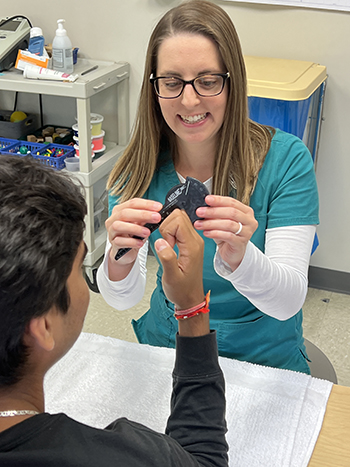The hidden Thanksgiving danger: Turkey carving
Orthopedics
If an accident happens, St. Joseph’s/Candler offers certified hand therapy for injuries to the hand, wrist and arm
Did you know that 88 percent of Americans eat turkey on Thanksgiving? It might be more surprising that 12 percent don’t. But to our main point: Did you also know that cuts from carving the bird are one of the top five most common injuries on this holiday?
It’s true, says Katelyn Ruggiero, an occupational therapist and certified hand therapist at St. Joseph’s Hospital Outpatient Rehabilitation. Every holiday season, Ruggiero sees patients with hand injuries from cutting. Additionally, as a hand therapist, she also treats a lot of fractures that occur due to the hustle and bustle of the holiday season.

You might not think a cut or injury to the hand would require therapy, but the hand is a complex body part. It’s made up of 27 bones and numerous muscles, ligaments and tendons. Additionally, there are arteries, veins and nerves within the hand that provide blood flow and sensation to the hand and fingers.
Also consider how important our hands are. We use them for writing, typing, texting, eating and so much more.
“Psychologically in conjunction with physically, an injury to the hand or wrist can be debilitating,” Ruggiero says. “You wouldn’t think about that with a hand injury, but when you can’t go back to work or can’t play with your grandkids, that can psychologically have some effects as well.”
What is hand therapy?
Hand therapy evaluates and treats injuries and conditions of the hand, as well as the shoulder, arm, elbow, forearm and wrist. Therapists use a number of methods, such as stretching, bending and positioning, to help you return to your highest level of function.
Hand therapy can help treat a number of conditions including fractures, flexor tendon injuries, nerve injuries, such as carpal tunnel syndrome, elbow ligament issues and so much more.
In order to become a certified hand therapist, you first become a certified occupational therapist and then work for at least three years, with at least 4,000 hours of working with the upper extremity. Then, you must past an intense exam that typically takes months to study for, Ruggiero says.
“I love all aspects of occupational therapy, but my passion is definitely orthopedic injuries or neurological issues related to the arm,” she says.
While we certainly don’t hope your Thanksgiving results in the need for hand therapy, Ruggiero is available to treat a variety of medical conditions. A physician’s referral is needed to see a hand therapist. 
“If you have symptoms that persist after a particular incident or the swelling or bruising gets worse, you should consult your doctor,” Ruggiero encourages. “Especially if you are noticing numbness or tingling in your hands or fingers that is consistently happening and getting worse, you should contact your doctor. The worse that it gets, the longer symptoms linger, it can complicate things in the future.”
Cutting and carving safety tips
Remembering to be safe when using a knife can help you avoid injury altogether. When carving this year’s Thanksgiving turkey, or anytime you are using a knife, consider these safety tips:
- Never cut towards yourself. One slip of the knife can cause a horrific injury. Your free hand should be placed opposite the side you are carving toward.
- Don’t place your hand underneath the blade to catch the slice of meat.
- Keep all cutting utensils sharp. If your knife is sharp enough, it should not need force in order to carve. A knife too dull to cut properly is still sharp enough to cause any injury.
- If possible, use an electric knife for the carving. Use kitchen shears to cut the bones and joints of the turkey or other poultry.
- Do not let children assist with carving, cutting or chopping.
- Keep your cutting area well-lit and dry. Good lighting will help prevent an accidental cut of the finger and making sure your cutting surface is dry will prevent ingredients from slipping while chopping.
- Keep your knife handles dry. A wet handle can prove slippery and cause your hand to slip down onto the blade.
- Don’t put knives in dishwater where they are not easily seen.
Should you cut your finger or hand, bleeding from minor cuts will often stop on its own by applying direct pressure to the wound with a clean cloth. Seek medical help if:
- Continuous pressure does not stop the bleeding after 15 minutes.
- You are unsure of your tetanus immunization status.
- You are unable to thoroughly cleanse the wound by rinsing with mild soap and plenty of clean water.
- You notice persistent numbness or tingling in the fingertip.
- You do not have full range of motion in the hand or finger.